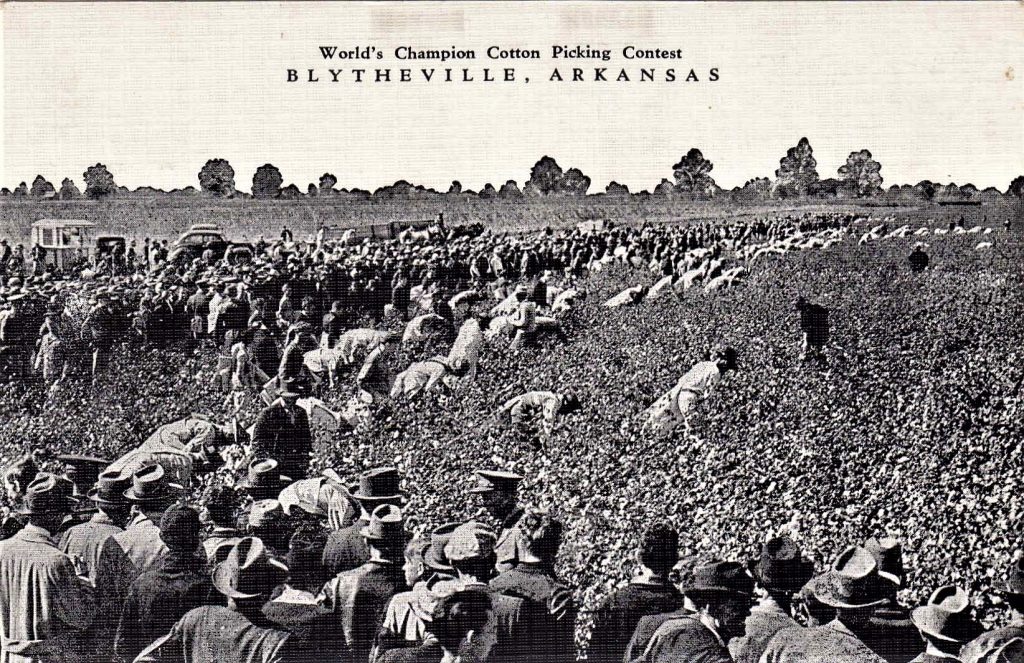Bill Burton
The World’s Champion
Cotton Picking Contest

Cotton was the most farmed crop in the southern and western parts of America well into the twentieth century. It was labor-intensive, needing large numbers of workers to plant, chop, and harvest. Cotton growing had expanded westward as far as Texas by the 1840s and by 1845 when Texas joined the union it had become the chief driver of the economy in the entire southern swath of the United States.
A blockade by the U. S. Navy during the Civil War strangled the cotton trade by stopping the delivery of cotton to Europe and halted the importation of war material into southern ports. After the war, the cotton trade rebounded, with the work formerly done by slaves now the province of tenant farmers and sharecroppers.
Cotton picking was hard work and offered little pay. There were periodic attempts by the tenant farmers and sharecroppers to get better wages, and in 1891 the members of the Colored Farmers National Alliance, allied with the [white] Farmers Alliance, called a strike when picking wages were limited by the growers’ association. The strike had limited success except in Lee County, Virginia (on Virginia’s border with Tennessee) where violence took the lives of both strikers and non-strikers. The strike led to the burning of a cotton gin and killing of a plantation owner. The aftermath was the lynching of nine strikers, an event memorialized by the Arkansas Gazette’s headline “Lee County Trouble Settled with Rope.” Other attempts by the tenants and sharecroppers also failed.
As early as 1850, inventors had been receiving patents for cotton harvesting devices, but none of the inventors succeeded in creating a viable machine. However, by the mid-1930s, two Texas brothers, John and Mack Rust, developed a workable picking machine but they were stymied by the Depression and lack of capital. After World War II, agricultural machinery makers like International Harvester, Deere and Company, and Allis Chalmers entered the business, but the complexities of harvesting cotton by machine were such that it wasn’t until the late 1950s and 1960s that mechanical harvesting began to take root.
Whether the Great Migration of poor white and African American farmers from the South to the North and West that began in the 1920s was because of the loss of jobs on the farms due to the fear of mechanization or the land becoming exhausted, or whether mechanization was stimulated by labor shortages due to out-migration, is debatable. The result, however, was the same — the rural South lost large portions of its population as better-paying manufacturing jobs attracted entire families to leave the farms and emigrate out of the South.
The motive for starting the National Picking Contest in Blytheville, Arkansas, in October 1940 is unclear. Like many communities, Blytheville was proud of its position as a center of the cotton industry and perhaps that was reason enough for the local cotton growers association to celebrate with a community fair.
From the start, the event attracted not just local competitors but drew from across the south. The winner was 15-year-old Harry Mason of Missouri, who received a prize of $1,000, paid out in one-dollar bills. The organizers made strenuous efforts to publicize the event with newspaper articles and newsreel coverage. This Movietone newsreel https://www.youtube.com/watch?v=K4S29vrbHz8 from the second contest in 1941 shows the competition and is narrated by Lowell Thomas, then perhaps the most famous broadcasting voice in America.
Another newsreel about the contest is at https://www.criticalpast.com/video/65675033546_Cotton-picking-contest_weighing-machine_end-of-competition_cotton-field.
in 1957, at the 18th annual contest, the Arkansas U.I. news produce a newsreel found at https://www.youtube.com/watch?v=r5_Hw2FciNg.
The contest evolved from a single event, an anyone-can-participate race to pick as much cotton as possible in two hours, to include specialized divisions for older people, women, and young people. By the seventh annual contest, on October 3, 1946, a full day of non-picking events was scheduled, including entertainment by Red Foley (a giant in the country music world), a speech by Oscar Johnston (founder and president of the powerful National Cotton Council), and “Our Miss America,” Becky Smith (who was to model clothing). Joe Sanders and his Nite Hawks (a popular radio jazz band that toured regularly throughout the Midwest) provided the music for the Cotton Ball, with dancing from 10 PM until ?.
The Blytheville contest faded in the 1960s but it was revived by a nearby city, Gosnell, in 1991. By the mid-2010s the cotton-picking aspect had run its course and the city now sponsors a Fall Festival.
Fantastic article! I’m also curious about your Ossining collection. Do you have any Sing Sing Prison ones?
When I lived in Ossining (until 2013) I was known as the King of Ossining Postcards — primarily because no one else collected them! I have scanned all my cards and have posted them at my website http://postcards.burtonandcompanyllc.com/PostcardCollectionSearch.aspx Select “NY Ossining” as the location and then “prison” as the subject, or just enter “Sing Sing” in the keywords box. One of my grail questions is to find what I believe is the missing 12th card published by T. Fred Robbins (I have 11 of his cards) which show the inside of the prison. You might also want to look at… Read more »
Interesting social history. I did not realise exports of cotton were curtailed during the civil war.
I was born in 1959 and remember hearing Lowell Thomas on the radio (he lived until 1981), but I’d be surprised if anyone much younger than I recognized Thomas’s name.
It’s really nice article about cotton history, i crochet a lot using cotton yarn.
Thanks for writing a charming article about a little known agricultural contest. The historic video clips complement the story nicely.